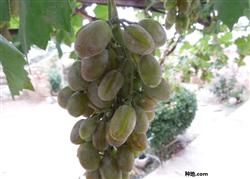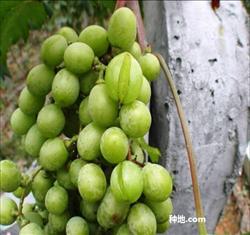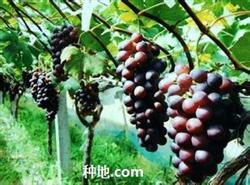Why do grapes split? How to prevent and cure

Why do grapes crack? How to prevent and seek advice Fresh grape is an important fruit tree species in China, but fruit cracking often occurs before harvest, especially in rainy years at the late stage of fruit maturity. Fruit cracking not only affects the appearance of fruit, but also leads to the infection of exogenous microorganisms and rot, which seriously reduces the commodity value of fruit. It is a physiological disease that cannot be ignored in production. 1. Types and manifestations of fruit cracking. Grape often split fruit in mature stage, loss is greater. Because of different varieties, the position and type of fruit cracking are different. Generally divided into dense grain type and thin grain type of two kinds of fruit cracking, its causes and mechanisms are also different. The reason for fruit cracking of dense type is that the fruit grains are closely connected at early stage and cork cracks are formed. With the development of fruit, a large amount of water absorption from pericarp and root produces intra-grain swelling pressure, and the fruit cracks at the crack part where the fruit grains contact. The fruit cracking of thin grain type belongs to the same principle, but the cracking position is not in the contact position of fruit grains, but near the fruit top or fruit pedicle with weak peel strength, and a large amount of water absorption promotes the cracking of fruit. Sometimes there are many fruits and many cracked fruits. There are three kinds of thin-grain fruit cracking: one is the top crack of fruit, which occurs at the root mark, the juice rarely overflows, basically does not infect the good fruit, the harm is small, but it occurs more commonly; the other is the crack of pedicle, that is, from the base of fruit stalk to the equator, the crack is large, the juice overflows, which has a great impact on the good fruit, once it occurs, the loss is serious; The third is the cork part crack, occurs in the fruit grain surface has the cork formation position, the juice few outflow, does not infect, the harm is small, but seriously endangers the fruit quality. 2. Causes of fruit cracking. It was mainly related to the weakness of pericarp tissue, especially the weakening of pericarp strength with the increase of fruit maturity, and on the other hand, it was related to the increase of internal turgor pressure caused by cultivation conditions and climate changes. Soil had the greatest influence on fruit cracking, and the hardened soil and clayey soil with poor drainage were more prone to drought and waterlogging. After transplanting trees, trees that have been sunburned have more cracked fruits; the number of fruits is also related to cracking fruits. Too many fruits are easy to crack fruits. In addition, rainy season, wet and dry changes in the coloring period, easy to occur fruit cracking; bad coloring trees and bad coloring years, fruit cracking occurs especially. The cork part cracks fruit, mainly because the space around the ear is too small. Under the action of wind, the fruit grains and branches rub to form cork, and local tissues become fragile. With the expansion of the fruit, the cork part cracks. In short, the fruit cracking of Kyoho grape is mainly due to the change of soil moisture. The fruit expands slowly in the second stage of fruit growth, and rapidly in the third stage. The fruit surface deforms, forming weak tissues such as cracks and depressions. The water absorption from the root and fruit surface produces swelling pressure, cracks and depressions split. Cracking fruit is also closely related to seedless fruit, no stone fruit cone head mark is large, rainy period this part is full of mold, thus damaging the pericarp and cracking, this is one of the reasons for cracking fruit. Another reason is that fruit cracking occurs in fruit grains with only a single seed. The single seed is biased to one side, and the side with seeds is well developed, while the side without seeds is poorly developed, and it is easy to crack at a slight impact. III. Preventive measures. The countermeasures for fruit cracking should be different according to different varieties. It is mainly to select and cultivate varieties that are not easy to crack fruits. The key to prevent and control fruit cracking of dense grain type is to keep proper fruit and prevent water absorption. Generally, 7-8 fruits can be planted on each 1 cm ear axis. The easiest way to prevent water absorption is fruit bagging. If protected cultivation can be carried out, the effect of preventing fruit cracking is better. The key to control the fruit cracking is to improve soil management, promote tree health, maintain normal fruit setting and stable fruit development conditions, properly promote early maturity and other measures to reduce fruit cracking. If it can be changed to greenhouse cultivation, the control effect will be better. 1. Improve soil structure and reduce soil moisture changes. Drainage should be done well through open channels, and soil permeability should be increased by ploughing and applying organic fertilizer to reduce changes in soil moisture. 2. Timely irrigation. Keep the soil water content (about 60%). Drought period, especially after the rainy season dry period, to timely irrigation. 3. Cover with plastic film. On the one hand, it can prevent the root system from absorbing too much water for a while after rainfall; on the other hand, it can inhibit soil moisture evaporation, reduce soil moisture change and maintain water balance. However, plastic film mulching should be combined with irrigation during drought. 4. Canopy shall be set on the frame surface, or ear bagging shall be used to prevent rainwater. Grape fruit surface direct absorption of rain, or from the root absorption of water, fruit swelling pressure, resulting in fruit cracking. The results showed that bagging the ear at the near maturity stage could reduce the cracking rate of the ear obviously. Therefore, taking rain protection measures in rainy days can effectively prevent fruit cracking. 5. Adjust the amount of results. Grape coloring bad trees, especially more fruit cracking, so through thinning ears, thinning seeds, pinching ear tips, adjust the amount of fruit, reduce fruit cracking. 6. Improve cultivation management. Under the condition of strengthening cultivation management and ensuring strong tree body, summer shearing should be strengthened to make ear distribution reasonable and not to rub with branches and leaves. At the same time, create good conditions for coloring. 7. Intertill weeding. Intertillage can eliminate weeds, reduce the occurrence of diseases and insect pests, and loosen the soil at the same time. It has the functions of raising moisture in drought, drying moisture in flood and regulating soil moisture content. Generally 10-15 days intertill once, after rain should be timely intertill to disperse moisture. Click to see more grape growing technology Click to see more fruit growing technology
- Prev

Why do grapes crack?
Why do grapes crack? What is the reason? The main reasons for grape fruit cracking are: 1. In the late stage of fruit growth, the soil moisture changes too much, and the roots absorb a large amount of water from the soil and transport it to the fruit. The physiological activities and division of the cells near the fruit brush accelerate, and near the pericarp.
- Next

How to grow American black grapes?
How to grow American black grapes? To find a way to grow American black grape, you can refer to the following methods: core hint: it is better to set up a garden on a leeward and sunny slope, and the soil quality requires sandy soil or loam with strong fertilizer and water conservation. Before planting, dig a planting ditch that is 100 cm deep and 80 cm wide. The bottom of the ditch is 667 meters 2 and the soil fertilizer is 40.
Related
- Moge, come on! The staff of the peasant association in the producing area of cantaloupe were frightened when the crowd gathered.
- Causes and Solutions of low Fruit setting rate of Apple
- Symptoms and control measures of passion fruit virus disease
- Fruit growing lesson: how do apple orchards keep high yields?
- Can you build orchards in the mountains? What are the pros and cons?
- How to manage the coloring period of Crisson grape?
- This paper introduces the processing technology of two kinds of fig products.
- How much is a month for retired teachers in rural areas by 2020?
- How can strawberry planting increase sugar content? We should pay attention to management in many aspects.
- What are the cultivation techniques on how to improve the yield of golden fruit?

